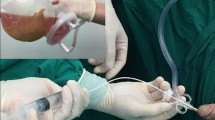Abstract
Purpose
To compare different treatment approaches in patients with failed ureteral access sheath placement during first flexible ureterorenoscopy (f-URS) session.
Methods
Patients with kidney stones measuring 1–2 cm, presented to our urology clinic between September 2020 and September 2021, were included in the study for evaluation. The study was designed prospectively (Clinical-Trials number NCT05911945). Patients were randomized into two groups, in case of a failed ureteral access sheath placement during the first f-URS session. In group 1, JJ stent was placed for dilation and second session of f-URS was planned. In group 2, mini percutaneous nephrolithotomy (mPNL) was performed in the same session.
Results
Twenty-four patients were included in each group. Pre-operative demographic data and stone characteristics of the patients in each group were comparable. Operation time, fluoroscopy time, and hospital stay were significantly higher in the mini-PNL group. When SF-36 values were compared, physical function, pain, role limitation, and general health value scores were improved in both groups after treatment. The improvement in physical function and pain parameters was statistically significant in the mPNL group. In patients with failed ureteral access sheath placement, placing a JJ stent for dilation and postponing f-URS for 4–6 weeks provides the advantages of low hospitalization time for each admission, shorter fluoroscopy and operation time.
Conclusions
Performing mPNL in the same session, results in better improvements in SF-36 parameters such as pain and physical function compared to f-URS. The success and complication rates of the two procedures were comparable.

Similar content being viewed by others
References
Raheem OA, Khandwala YS, Sur RL, Ghani KR, Denstedt JD (2017) Burden of urolithiasis: trends in prevalence, treatments, and costs. Eur Urol Focus 3(1):18–26. https://doi.org/10.1016/j.euf.2017.04.001
Marcovich R, Smith AD (2003) Renal pelvic stones: choosing shock wave lithotripsy or percutaneous nephrolithotomy. Int Braz J Urol 29(3):195–207. https://doi.org/10.1590/s1677-55382003000300002
Assimos D, Krambeck A, Miller NL et al (2016) Surgical management of stones: American urological association/endourological society guideline PART I. J Urol 196(4):1153–1160. https://doi.org/10.1016/j.juro.2016.05.090
Srisubat A, Potisat S, Lojanapiwat B, Setthawong V, Laopaiboon M (2014) Extracorporeal shock wave lithotripsy (ESWL) versus percutaneous nephrolithotomy (PCNL) or retrograde intrarenal surgery (RIRS) for kidney stones. Cochrane Database Syst Rev. https://doi.org/10.1002/14651858.CD007044.pub3
Chang X, Wang Y, Li J, Han Z (2021) Prestenting versus nonprestenting on the outcomes of flexible ureteroscopy for large upper urinary stones: a systematic review and meta-analysis. Urol Int 105(7–8):560–567. https://doi.org/10.1159/000506652
Pérez-Fentes DA, Gude F, Blanco B, Freire CG (2015) Percutaneous nephrolithotomy: short-and long-term effects on health-related quality of life. J Endourol 29(1):13–17. https://doi.org/10.1089/end.2014.0081
Ware JE Jr, Sherbourne CD (1992) The MOS 36-item short-form health survey (SF-36). I. conceptual framework and item selection. Med Care 30(6):473–483. https://doi.org/10.1097/00005650-199206000-00002
Junbo L, Yugen L, Guo J, Jing H, Ruichao Y, Tao W (2019) Retrograde intrarenal surgery vs. percutaneous nephrolithotomy vs. extracorporeal shock wave lithotripsy for lower pole renal stones 10–20 mm : a meta-analysis and systematic review. Urol J 16(2):97–106. https://doi.org/10.22037/uj.v0i0.4681
Kiremit MC, Guven S, Sarica K et al (2015) Contemporary management of medium-sized (10–20 mm) renal stones: a retrospective multicenter observational study. J Endourol 29(7):838–843. https://doi.org/10.1089/end.2014.0698
Akbulut F, Kucuktopcu O, Kandemir E et al (2016) Comparison of flexible ureterorenoscopy and mini-percutaneous nephrolithotomy in treatment of lower calyceal stones smaller than 2 cm. Ren Fail 38(1):163–167. https://doi.org/10.3109/0886022X.2015.1128792
Yanaral F, Ozgor F, Kucuktopcu O et al (2019) Comparison of flexible ureterorenoscopy and mini percutaneous nephrolithotomy in the management of multiple renal calculi in 10–30 mm size. Urol J 16(4):326–330. https://doi.org/10.22037/uj.v0i0.3310
Ergin G, Kirac M, Kopru B, Ebiloglu T, Biri H (2018) Flexible ureterorenoscopy versus mini-percutaneous nephrolithotomy for the treatment of renal stones. Urol J 15(6):313–317. https://doi.org/10.22037/uj.v0i0.4208
Davis NF, Quinlan MR, Poyet C et al (2018) Miniaturised percutaneous nephrolithotomy versus flexible ureteropyeloscopy: a systematic review and meta-analysis comparing clinical efficacy and safety profile. World J Urol 36(7):1127–1138. https://doi.org/10.1007/s00345-018-2230-x
Xu C, Song R, Lu P, Jiang M, Zeng G, Zhang W (2020) A retrospective study comparing super-mini percutaneous nephrolithotomy and flexible ureteroscopy for the treatment of 20–30 mm renal stones in obese patients. PeerJ 10(8):e8532. https://doi.org/10.7717/peerj.8532
Wang F, Hong Y, Yang Z, Ye L (2021) Comparison of retrograde intrarenal surgery and standard percutaneous nephrolithotomy for management of stones at ureteropelvic junction with high-grade hydronephrosis. Sci Rep 11(1):14050. https://doi.org/10.1038/s41598-021-93551-8
Coskun A, Eryildirim B, Sarica K, Çamur E, Can U, Saglam E (2021) Comparison of mini percutaneous nephrolithotomy (mini PCNL) and retrograde intrarenal surgery (RIRS) for the minimal invasive management of lower caliceal stones. Urol J. https://doi.org/10.22037/uj.v18i07.6443.10.22037/uj.v18i07.6443
Zeng G, Zhang T, Agrawal M et al (2018) Super-mini percutaneous nephrolithotomy (SMP) vs retrograde intrarenal surgery for the treatment of 1–2 cm lower-pole renal calculi: an international multicentre randomised controlled trial. BJU Int 122(6):1034–1040. https://doi.org/10.1111/bju.14427
Bensalah K, Tuncel A, Gupta A, Raman JD, Pearle MS, Lotan Y (2008) Determinants of quality of life for patients with kidney stones. J Urol 179(6):2238–2243. https://doi.org/10.1016/j.juro.2008.01.116
Author information
Authors and Affiliations
Corresponding author
Ethics declarations
Conflict of interest
The authors have no conflicts of interest to declare. All coauthors have seen and agree with the contents of the manuscript and there is no financial interest to report. We certify that the submission is original work and is not under review at any other publication.
Additional information
Publisher's Note
Springer Nature remains neutral with regard to jurisdictional claims in published maps and institutional affiliations.
Rights and permissions
Springer Nature or its licensor (e.g. a society or other partner) holds exclusive rights to this article under a publishing agreement with the author(s) or other rightsholder(s); author self-archiving of the accepted manuscript version of this article is solely governed by the terms of such publishing agreement and applicable law.
About this article
Cite this article
Caglar, U., Erbin, A., Ucpinar, B. et al. Failed insertion of ureteral access sheath during flexible ureterorenoscopy: a randomized controlled trial comparing second session flexible ureterorenoscopy or same session mini percutaneous nephrolithotomy. Int Urol Nephrol 56, 433–439 (2024). https://doi.org/10.1007/s11255-023-03820-w
Received:
Accepted:
Published:
Issue Date:
DOI: https://doi.org/10.1007/s11255-023-03820-w




